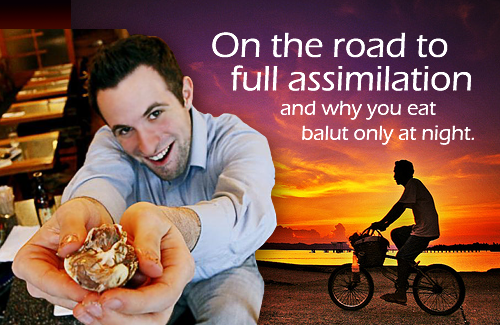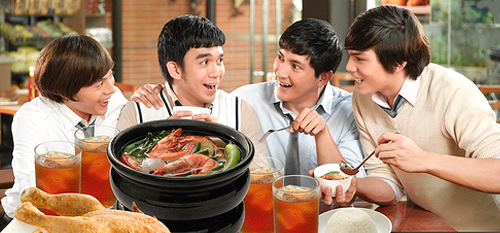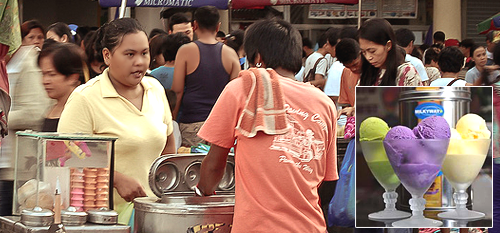
Editor’s Note: The following post is from a British journalist Matthew Sutherland who wrote it while stationed as an expat in the Philippines. A subscriber of Filipinos in Christchurch provided a copy with a suggestion to republish it on this website. That is largely because she found Mr. Sutherland’s observations so ‘hilarious’ and now that more skilled Filipinos are arriving in Christchurch to help in the huge reconstruction effort wonders what they themselves might write regarding their own new experien ces with Kiwi culture in the South Island.
“Matter of Taste”
By Matthew Sutherland
“Metro Manila, Philippines
I have now been in this country for over six years, and consider myself in most respects – well, assimilated. However, there is one key step on the road to full assimilation, which I have yet to take, and that’s to eat balut.
The day any of you see me eating balut, please call (Philippine) immigration and ask them to issue me a Filipino passport because at that point, there will be no turning back.
Balut, for those still blissfully ignorant non-Pinoys out there, is a boiled fertilised duck egg. It is commonly sold with salt in a piece of newspaper, much like English fish and chips, by street vendors usually after dark, presumably so you can’t see what’s inside the duck egg.
It’s meant to be an aphrodisiac, although delicious I can’t imagine anything more likely to dispel sexual desire than crunching on a partially formed baby duck swimming in it embryonic fluid. The embryo in the egg comes in varying stages of development, but basically it is not considered macho to eat one without fully discernible feathers, beak, and claws. Some say these crunchy bits are the best. Others prefer just to drink the so-called ‘soup’, the savory-like pungent liquid that surrounds the aforementioned feathery fetus.

Food dominates the life of the Filipino. People here just l-o-v-e to eat.
They eat at least eight times a day. These eight official meals are called, in order: breakfast, snacks, lunch, merienda, merienda cena, dinner, bedtime snacks and no-one-saw-me-take-that-cookie-from- the-fridge-so-it-doesn’t-count.
The short gaps in between these mealtimes are spent eating Sky Flakes crackers from the open packet that sits on every desktop. You’re never far from food in the Philippines. If you doubt this, next time you’re driving home from work, try this game. See how long you can drive without seeing food and I don’t mean a distant restaurant, or a picture of food. I mean a man on the sidewalk frying fish balls, or a man walking through the traffic selling nuts or candy. I bet it’s less than one minute.
Here are some other things I’ve noticed about food in the Philippines:
Firstly, a meal is not a meal without rice – even breakfast. In the UK, I could go a whole year without eating rice. Second, it’s impossible to drink without eating. A bottle of locally-brewed San Miguel (beer, which is one of the best in the world) just isn’t the same without gambas or beef tapa. Third, no one ventures more than two paces from their house without baon (food in a small container or wrapped in wax paper and pronounced as ‘baaah-un’) and a container of something cold to drink. You might as well ask a Filipino to leave home without his pants on. And lastly, where I come from, you eat with a knife and fork.
Here, you eat with a spoon and fork. You try eating rice swimming in fish sauce with a knife! Makes sense.

One really nice thing about Filipino food culture is that people always ask you to SHARE their food. They’re such a loving, joyful and happy people.
In my office, if you catch anyone munching on their baon, they will always go, ‘Sir! kain tayo!‘ (‘Let’s eat!’). This confused me, until I realised that they didn’t actually expect me to sit down and start munching on their boneless bangus (milk fish). In fact, the polite response is something like, ‘No thanks, I just ate.’ But the principle is sound – if you have food on your plate, you are expected to share it, however hungry you are, with those who may be even hungrier. I think that’s great attribute about Filipinos!
In fact, this is frequently even taken one step further. Many Filipinos use ‘Have you eaten yet?’ (‘Kumain ka na?‘) as a general greeting, irrespective of time of day or location to check on your well-being.
Some foreigners think Filipino food is fairly dull compared to other Asian cuisines. Actually lots of it is very good:
Spicy dishes like Bicol Express (strange, a dish named after a train); anything cooked with coconut milk (yummy); anything Kinilaw (drenched in vinegar); and anything Adobo. And it’s hard to beat the sheer wanton, cholesterolic frenzy of a good old-fashioned Lechon de leche (golden roasted pig) feast. Dig a pit, light a fire, add 50-pounds of animal fat on a stick, and cook until crisp. Mmm, mmm… you can actually feel your arteries constricting with each successive mouthful. But it’s delicious!

I also share one key Pinoy trait – a sweet tooth. I am thus the only foreigner I know who does not complain about sweet bread, sweet burgers, sweet spaghetti, sweet banana ketchup, and so on. I am a man who likes to put jam on his pizza. Try it! It’s one weird food you want to avoid.
In addition to boiled duck fetus in the half-shell, other exotic items to avoid in the Philippines if you haven’t lived here long enough include pig’s blood soup (Dinuguan); bull’s testicle soup, the strangely-named ‘Soup Number Five’ (I dread to think what numbers one through four are); and the ubiquitous, aroma tic shrimp paste, Bagoong, and it’s equally sharp tasting (fermented fish sauce) sister, Patis.
Filipinos are so addicted to these latter items that they will even risk arrest or deportation trying to carry a large supply of these into countries like Australia and the USA, which wisely ban the importation of items unless properly sealed.
Then there’s the small matter of the bluish-purple coloured ice cream. I have never been able to get my brain around eating oddly-coloured food; the ubi quitous Ube (a tuber) which left me wondering until I actually tried it. Fabulous!
The Filipino, of course, has a well-developed if not keen sense of food. Here’s a typical Pinoy food joke: ‘I’m on a seafood diet. ‘What’s a seafood diet?’ ‘When I see food, I eat it!’
Filipinos also eat strange bits of animals too – the feet, the head, the guts, etc., usually barbecued on a stick drenched in a marinade that’s marvelous. These have been given witty names, like ‘didas’ (chicken’s feet); ‘kurbata‘ (either just chicken’s neck, or ‘neck and thigh’ as in ‘neck-tie’); ‘walkman’ (pigs ears); ‘pal‘ (chicken wings, connoting ‘Philippine Air Lines’); ‘helmet’ (chicken head); ‘IUD’ (chicken intestines), and ‘Betamax’ (video-cassette-like blocks of animal blood). Yum, yum. Bon appetit!

‘A good name is rather to be chosen than great riches‘ – (Proverbs 22:1)
When I arrived in the Philippines from the UK six years ago, one of the first cultural differences to strike me was names. The subject has provided a conti nuing source of amazement and amusement ever since. The first unusual thing, from an English perspective, is that everyone here has a nickname. In the staid and boring United Kingdom, we have nicknames in kindergarten, but when we move into adulthood we tend, I am glad to say, to lose them.
The second thing that struck me is that Philippine names for both girls and boys tend to be what we in the UK would regard as overbearingly cutesy for anyone over about five. A fifty-five-year-old colleague put it this way: “Where I come from, a boy with a nickname like Boy Blue or Honey Boy would be beaten to death at school by pre-adolescent bullies, and never make it to adulthood. So, probably, would girls with names like Babes, Lovely, Precious, Peachy or Ap ples.”
Here, however, no one bats an eyelid.
Then I noticed how many people have what I have come to call “door-bell names”. These are nicknames that sound like – well, doorbells. There are millions of them. Bing, Bong, Ding, and Dong are some of the more common. They can be, and frequently are, used in even more door-bell-like combinations such as Bing-Bong, Ding-Dong, Ting-Ting, and so on. Once, even a newly-appointed Philippine Chief of Police had a doorbell name Ping. None of these doorbell names exist where I come from, and hence sound unusually amusing and melodic to my un tutored foreign ear.
Someone once told me that one of the Bings, when asked why he was called Bing, replied, ‘because my brother is called Bong’. Faultless logic! Dong, of course, is a particularly funny one for me, as where I come from ‘dong’ is a slang word for well… perhaps ‘talong‘ (eggplant) is the best Tagalog equivalent.
Repeating names was another novelty to me, having never before encountered people with names like Len-Len, Let-Let, Mai-Mai, or Ning-Ning. The secretary I inherited on my arrival had an unusual one: Leck-Leck. Such names are then frequently further refined by using the ‘squared’ symbol, as in Len2 or Mai2. This had me very confused for a while but you catch on quickly. Pretty inventive people, Filipinos.
_____________________________________________________________
Watch The Video
The Filipino accent is warm, high-spirited, full of culture, unique, disarming and is bound to make anyone smile when they first come to hear it. Mikey Bustos, a 32-year old Filipino-Canadian comedian renowned the world over for his videos uploaded on YouTube, has become a phenomenon for his ‘tutorial’ parodies which exaggerate Filipino mannerisms, habits and cultural traits that border on the hilarious even for Filipinos themselves. For Mikey, these features are in his opinion what characterize the Filipino people. That said, he has admitted that he makes his videos “because the world needs to see how unique and beautiful the culture of the Philippines is as the only time Filipinos make it on the news in other countries like Canada is when there is a natural disaster or some kind of corruption exposé in the government. That’s all they know about Filipinos and to him (and millions of other Filipinos around the world) that’s a false representation of what the Philippines is truly like.
Then there is the trend for parents to stick to a theme when naming their children. This can be as simple as making them all begin with the same letter in the alphabet, as in Jun, Jimmy, Janice, and Joy.
More imaginative parents shoot for more sophisticated forms of assonance or rhyme, as in Biboy, Boboy, Buboy, Baboy (notice the names get worse the more kids there are; best to be born early or you could end up being called Baboy (pig).
Even better, parents can create whole families of, say, desserts (Apple Pie, Cherry Pie, Honey Pie) or flowers (Rose, Daffodil, Tulip). The main advantage of such combinations is that they also look great painted across your trunk if you’re a cab driver. That’s another thing I’d never seen before coming to Manila – taxis with the driver’s kids’ names on the trunk.
Another whole eye-opening field for the foreign visitor is the phenomenon of the ‘composite’ name. This includes names like Jejomar (for Jesus, Joseph and Mary), and the remarkable Luzviminda (for the main islands of Luzon, Visayas and Mindanao in the archipelago, believe it or not). That’s a bit like me being called something like Engscowani (for England, Scotland, Wales and Northern Ireland). Between you and me, I’m glad I’m not because theirs seem to sound better. Engscowani?

The Filipinos’ love for wordplay is legendary just as much as it is here when a very popular lemon-flavoured fizz drink that goes by the name of L&P claims tongue-in-cheek that it is ‘World Famous in New Zealand”. The difference is the Philippines’ takes it a mile further with a vast collection of hilarious business names and signs that are found all over the country. Here an example for a street food kiosk’s name that offers kikiam (fried meatloaf sandwich cut into strips), siomai (dimsum) and fishballs: Kik-Mai-Bols. Then there’s a signboard beside a construction site: Erection in Progress. Or, here’s one of a stand that sells comic books: Words of Wisdumb. Whether clever or naughty, obscure or obvious, these unexpected offspring (and malapropisms) of the English language and Filipino wit are also serendipitous and ubiquitous, appearing just when and where you weren’t looking – and so much funnier for it. Many are so clever that you just have to admire the creativity that makes it possible. We’re sure the people behind these names and unpretentious phrases they’ve made up never took branding and advertising courses.
And how could I forget to mention the fabulous concept of the randomly inserted letter ‘h’. Quite what this device is supposed to achieve, I have not yet figured out, but I think it is designed to give a touch of class to an otherwise only averagely common name. It results in creations like Bhoy, Jhun, Lhenn, Ghem ma, and Jhimmy. Or how about Jhun-Jhun (Jhun2)?
How utterly boring to come from a country like the UK full of people with names like John Smith. How wonderful to come from a country where imagination and exoticism rule the world of names.
Even the towns here have exotic names; my top favourite is the unbelievably named town of Sexmoan, ironically located close to the cities of Olongapo and Angeles (where the former U.S Air Force and Naval bases were for a long time stationed). Where else in the world could that really be true?
Where else in the world could the head of the Catholic Church really be called Cardinal Sin? Where else but the Philippines!
Note: Philippines had a senator named Joker, and it is his legal name!
Filipinos in Christchurch | A Brit’s Culture Shock
_____________________________________________________________

 During the Spanish
During the Spanish






























